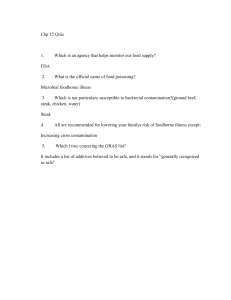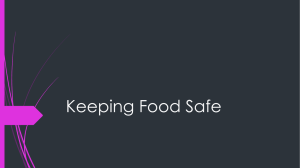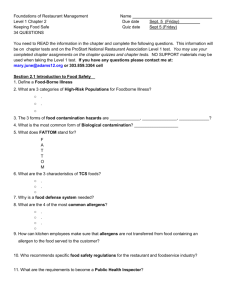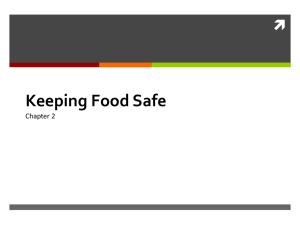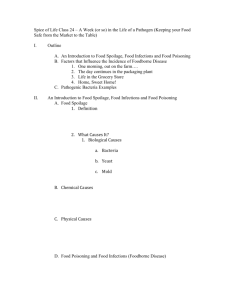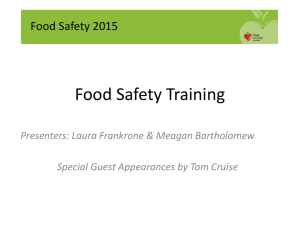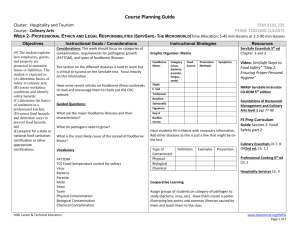Food Safety Worksheet: Chapter 2 Review
advertisement
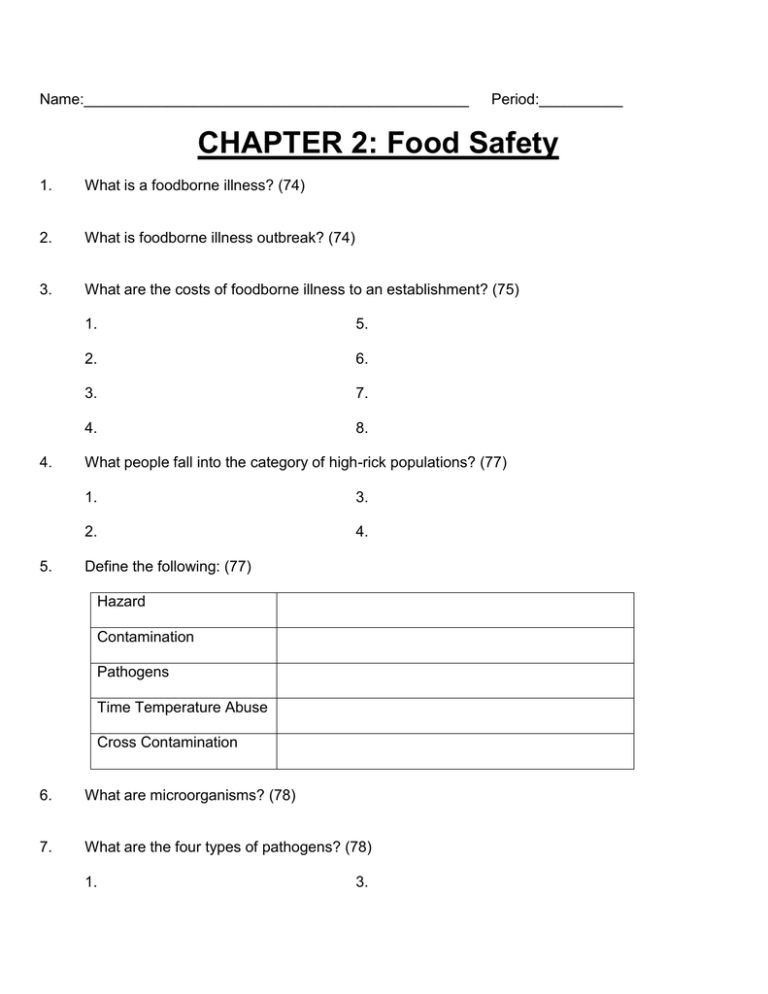
Name:______________________________________________ Period:__________ CHAPTER 2: Food Safety 1. What is a foodborne illness? (74) 2. What is foodborne illness outbreak? (74) 3. What are the costs of foodborne illness to an establishment? (75) 4. 5. 1. 5. 2. 6. 3. 7. 4. 8. What people fall into the category of high-rick populations? (77) 1. 3. 2. 4. Define the following: (77) Hazard Contamination Pathogens Time Temperature Abuse Cross Contamination 6. What are microorganisms? (78) 7. What are the four types of pathogens? (78) 1. 3. 2. 8. 4. What are the 6 conditions needed for pathogens to grow? (78-79) F A T T O M 9. What does TCS stand for? (78) 10. What is the temperature danger zone? (79) 11. Besides milk and meat products list 6 other foods that are most likely to become unsafe. (80) 1. 4. 2. 5. 3. 6. 12. Describe how viruses are transferred and the best prevention. (81) 13. Give two examples of a virus. (81) 14. What controls bacterial growth? (82) 15. Give three examples of a foodborne bacteria. (82) 16. Describe how parasites can show up in food. (82) 17. What is fungi most commonly responsible for? (82) 18. What reaction does mold have on food? (83) 19. What food is mold intentionally added to? (83) 20. How do you know if food is spoiled by yeast? (83) 21. What are some foods that have biological toxins? (84) 22. How can you prevent chemical contamination? (84) 23. Give 5 examples of physical contamination. (85) 1. 4. 2. 5. 3. 24. List the 8 common food allergies. (86-87) 25. What government agency prepare the Food Code? (89) 26. How can food handlers contaminate food? (94-95) 1. 5. 2. 6. 3. 7. 4. 27. What are the four suggestions for personal cleanliness and work attire? (95) 1. 3. 2. 4. 28. 29. When should food handlers wash their hands? List 6. (97) 1. 4. 2. 5. 3. 6. What are the 5 steps to proper handwashing? (98) 1. 4. 2. 5. 30. 3. What is the rule for handling ready-to-eat foods? (99) 31. When should you stay home from work? Why? (100) 32. What are three ways to prevent cross contamination? (105) 33. If food is held in the temperature danger zone 41-135, at what point should you throw it out? (105) 34. Describe each of the following thermometers: (106-108) Bimetallic Thermocouples Infrared 35. 36. What are 4 signs that food has been temperature abused? (110) 1. 3. 2. 4. What is FIFO? (111) 37. In the refrigerator what is the order that food should be stored from the top shelf to the bottom? (112) (read the paragraph) 1. 4. 2. 5. 3. 38. 39. What are 4 proper ways to thaw food? (113) 1. 3. 2. 4. What is the correct temperature for cooking the following foods? (115) Poultry (whole or ground) Ground meat (beef, pork, lamb) Seafood, Eggs Roast or Steaks beef, pork, lamb) Processed or ready-to-eat-food that will be held Fruit, vegetables, grains, legumes that will be held 40. What is the safe temperature to hold hot food? (116) 41. What are the temperature guidelines for cooling food? (117) Within the first 2 hours In the next 4 hours 42. What are three things you can do to cool food quickly and safely? (118) 1. 3. 2. 43. To what temperature does food need to be reheated to and in how many hours does that need to be accomplished? (118) 44. What are the 5 guidelines for serving food? (120) 1. 4. 2. 5. 3. 45. What is HACCP and what does each letter stand for? (126) 46. List and explain the seven steps of HACCP? (127-131) 1. 2. 3. 4. 5. 6. 47. 7. What is the difference between cleaning and sanitizing? (135) Cleaning: Sanitizing: 48. What are two methods of sanitizing? Quickly explain each. (138) 1. 2. 49. What are the 5 steps for using a three-compartment sink in dish washing? (139-140) 1. 4. 2. 5. 3. 50. What are the three basic rules for an Integrated Pest Management Program? (144) 1. 3. 2. 51. Exam Prep Questions 1. _____ 2. _____ 3. _____ 4. _____ 5. _____ 6. _____ 7. _____ 8. 9. 10. 11. 12. 13. _____ _____ _____ _____ _____ _____
